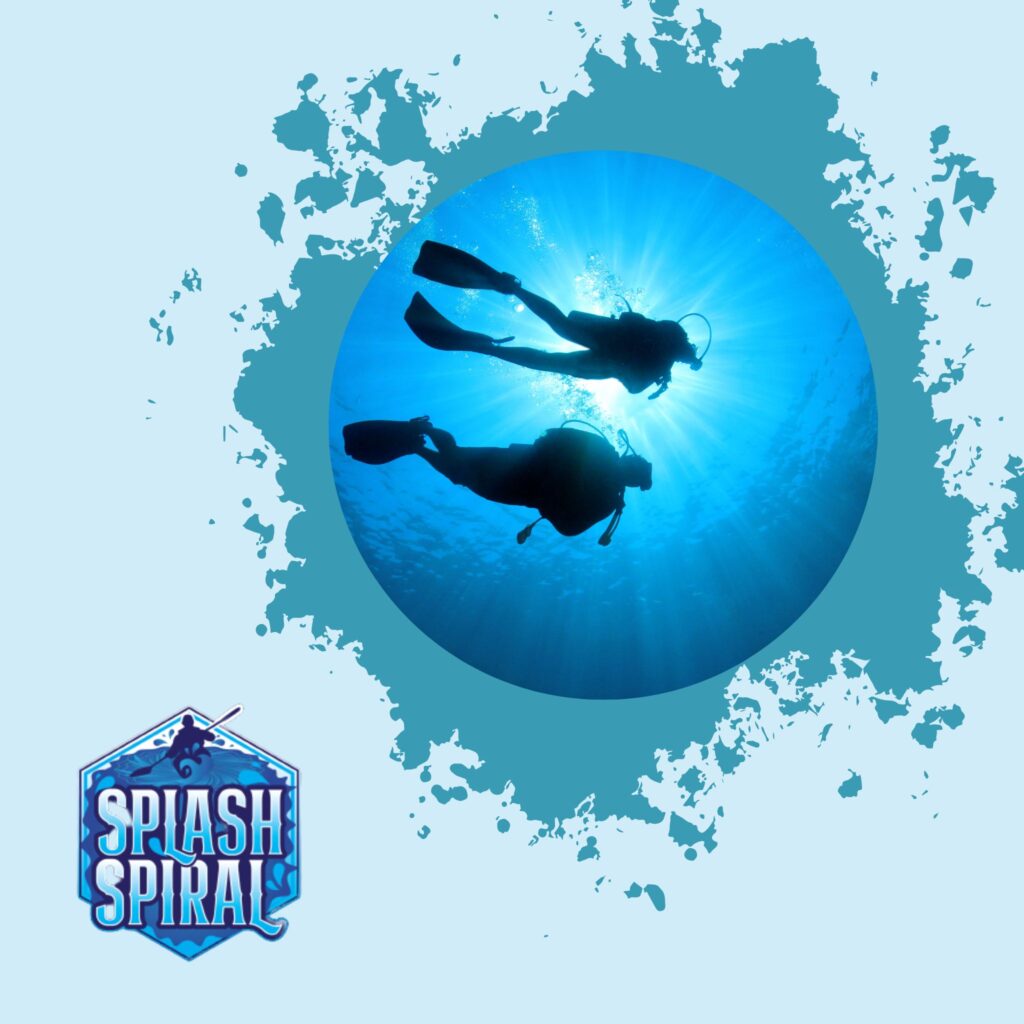Scuba Diving: Unleash the Underwater Adventure: A Comprehensive Guide
Scuba diving is a thrilling activity that allows individuals to explore the underwater world. From swimming with colorful fish to discovering lost treasures, scuba diving offers endless possibilities for adventure and excitement. However, before diving in headfirst, it’s crucial to learn about scuba diving and what it entails. So you prepare yourself well for this exciting sort of diving.

The Thrill of Scuba Diving
One of the most exciting aspects of scuba diving is the feeling of weightlessness as you float through the water. It’s like flying through a different world where gravity doesn’t exist. The thrill of exploring new environments, discovering unique marine life, and experiencing new sensations is what draws many people to scuba diving.
The Importance of Learning About Scuba Diving
While scuba diving can be an exhilarating experience, it also comes with inherent risks that must be taken seriously. Before jumping into the water, it’s essential to understand how your body reacts to pressure changes and how to properly use your equipment for safety purposes.
Learning about scuba diving also involves understanding the importance of respecting marine life and preserving underwater ecosystems. This means being mindful of not disturbing or damaging coral reefs or interacting with wildlife in a harmful way.
While scuba diving can be a thrilling activity full of adventure and exploration, it’s important to learn about its complexities before trying it out. By doing so, you can ensure your safety while enjoying all that the underwater world has to offer.
Finding a Reputable Scuba Diving School or Instructor
Scuba diving is a thrilling and exciting activity, but it’s important to learn from experienced professionals in a safe environment. Finding a reputable scuba diving school or instructor is crucial to learning proper techniques and safety protocols.
Before enrolling in a scuba diving course, take the time to research different schools and instructors in your area. Look for accreditation from organizations like PADI (Professional Association of Diving Instructors) or NAUI (National Association of Underwater Instructors).
These certifications ensure that the instructor has undergone rigorous training and has met specific standards for teaching scuba diving. It’s also important to read reviews from former students before making your decision.
Look for feedback about the instructor’s teaching style, safety protocols, equipment maintenance, and overall experience. Don’t be afraid to ask questions or request additional information before committing to a course.
Sorts of scuba diving
There are a couple of disciplines you can do inside the scuba diving world. We will explain each one of them below.
Deep Sea diving
This type of diving involves descending beyond the standard recreational diving limit of 130 feet (40 meters). Deep diving requires specialized training, equipment, and planning, as there are increased risks such as narcosis, decompression sickness, and oxygen toxicity. For more information check out our article about deep sea diving.
Wreck diving
Wreck diving is the exploration of shipwrecks and other underwater structures, such as airplanes or artificial reefs. This type of diving often requires penetration into the structure, necessitating specialized training and equipment to ensure safety. For more information check out our article about wreck diving.
Cave diving
This type of diving involves exploring underwater cave systems. It requires specialized training and equipment, as well as extensive planning and adherence to safety procedures, due to the potential hazards of limited visibility, confined spaces, and the risk of getting lost. For more information check out our article about cave diving.
Ice diving
Ice diving takes place beneath the frozen surface of a body of water, such as a lake or a pond. Divers require specialized equipment, including dry suits and proper thermal protection, as well as training in ice diving procedures and safety precautions. For more information check out our article about ice diving.
Reef diving
Reef diving involves exploring coral reefs and the diverse marine life that inhabits them. This type of diving is popular among recreational divers and typically takes place in shallow, clear waters, making it accessible to divers of various skill levels. For more information check out our article about reef diving.
Drift diving
Drift diving is a type of diving where divers are carried along by the current, allowing them to cover greater distances without expending much energy. This type of diving can be both exciting and relaxing, but requires good buoyancy control and awareness of the surroundings to ensure safety. For more information check out our article about drift diving.
Night diving
Night diving takes place after sunset and offers a completely different underwater experience, as many marine creatures exhibit different behaviors and are more active at night. Divers need specialized equipment, such as dive lights, and must be comfortable with limited visibility and navigation in darkness. For more information check out our article about Night diving.
Muck diving
Muck diving is the exploration of underwater environments with limited visibility and sandy or silty bottoms, which are often rich in unique and unusual marine life. Divers need excellent buoyancy control and a keen eye to spot the well-camouflaged creatures that inhabit these environments. For more information check out our article about muck diving.
Altitude diving
Altitude diving takes place in bodies of water located at high elevations, typically above 1,000 feet (300 meters). Due to the reduced atmospheric pressure at altitude, divers must adjust their dive planning and decompression calculations to account for these changes and avoid decompression sickness. For more information check out our article about altitude diving.
Decompression diving
Decompression diving involves dives that require mandatory decompression stops during ascent to allow the body to eliminate absorbed nitrogen and avoid decompression sickness. This type of diving requires advanced training, careful planning, and the use of specialized equipment, such as dive computers and additional gas supplies. For more information check out our article about decompression diving.
Open water diving
Open water diving refers to any type of scuba diving that takes place in non-confined waters such as seas, oceans, and lakes. It is the most common form of recreational diving and the starting point for most divers. Open water diving introduces divers to the basic principles of scuba diving, including dive planning, equipment usage, and underwater navigation.
The term “open water” often refers to the certification level required to dive independently of a diving instructor. The Open Water Diver certification typically involves a combination of theory lessons, confined water dives (in a swimming pool) to practice skills, and open water dives to experience the real underwater world.
The environment for open water diving can range from calm and clear tropical seas with vibrant coral reefs, to cooler, nutrient-rich waters that are home to a wide variety of marine life. Divers must be aware of the challenges that come with open water diving such as currents, wave action, and navigation.
Fresh water diving
Freshwater diving, as the name implies, takes place in fresh bodies of water like lakes, rivers, quarries, and even man-made pools. Freshwater environments often offer unique diving experiences and present different challenges compared to saltwater or open water diving.
The buoyancy control in freshwater is different due to the difference in density between fresh and salt water. Divers are less buoyant in freshwater, and therefore, may need to adjust their weight system accordingly.
Freshwater environments can present unique visibility conditions, ranging from crystal clear waters in certain lakes and springs to limited visibility in others, particularly in stagnant or slow-moving bodies of water.
One of the main attractions of freshwater diving is the chance to explore diverse environments such as submerged forests, underwater caves, and sunken man-made structures. There’s also a range of marine life in freshwater environments, different from what’s found in oceans and seas.
Freshwater diving can also include ice diving, where divers go under the ice layer of a frozen lake or pond. Cave diving, another specialized form of freshwater diving, involves exploring underwater cave systems.
Both open water and freshwater diving offer their own unique set of challenges and experiences, broadening the scope for exploration and discovery in the underwater world. As with all types of scuba diving, proper training and preparation are key to ensuring safety and enjoyment.
Understanding The Basic Equipment Needed for Scuba Diving
Scuba diving requires specialized gear to breathe underwater safely and comfortably. Here are some of the basic pieces of equipment you’ll need: Diving Mask: A mask covers your eyes and nose, allowing you to see underwater while keeping water out.
Wetsuit: Wetsuits are made of neoprene material that keeps you warm by trapping a thin layer of water between your skin and the suit. Buoyancy Control Device (BCD): The BCD is an inflatable vest that helps you control your buoyancy while underwater.
Regulator: The regulator attaches to the tank and allows you to breathe compressed air while underwater. Dive Computer: A dive computer tracks depth, time underwater, air supply, ascent rate, and other important metrics during a dive.
Make sure all equipment is in good condition and fits properly before diving. It’s also important to learn how to use each piece of equipment and practice safety protocols before entering the water.
The Science Behind Scuba Diving
How pressure affects the body underwater
When you scuba dive, you are essentially exploring an environment that is not designed for human habitation. The deeper you go, the greater the pressure around your body becomes.
At depth, your body will experience changes in temperature and pressure that can affect your comfort and put your safety at risk. The first thing to understand about diving is that water is much denser than air.
As you descend into the water, the weight of the water above you compresses your body. This change in pressure can have several effects on your body, including causing discomfort or even pain in various parts of your body like ears or sinuses.
To prevent these issues, divers equalize their ears and mask by exhaling through their nose while pinching them shut. Additionally, divers must pay attention to their air consumption as breathing compressed air at depth can lead to nitrogen narcosis which impairs judgment and can be dangerous if not managed properly.
Understanding buoyancy and how to control it
Buoyancy control is one of the most important skills for any scuba diver to master. It allows them to stay at a safe depth, conserve energy and better observe marine life without disturbing it.
One factor affecting buoyancy is weight: wearing too much gear or weights can make a diver sink too quickly while carrying too little gear may not provide enough stability for a comfortable dive. Another important factor in buoyancy control is controlling breathing.
By inhaling deeply, divers help themselves rise up while exhaling helps them descend lower into the water column. Special equipment like BCD (Buoyancy Control Device) further helps regulating buoyancy by inflating/deflating with air taken from/returned to tanks during each breath taken from regulator.
It’s important for beginners to practice buoyancy control until they can maintain a steady depth without over or under inflating their BCD. Good buoyancy control allows divers to move through the water effortlessly, observe marine life without disturbing it and conserves valuable energy.
Exploring Underwater Life
Different types of marine life you can encounter while scuba diving
Scuba diving isn’t just about exploring the depths of the ocean, but also about appreciating the diverse and colorful underwater world that exists below the surface. Every dive is a new opportunity to encounter fascinating marine creatures like sea turtles, rays, eels, octopuses, and even sharks.
While some species may be intimidating at first sight, it’s important to remember that they are not aggressive and likely more scared of us than we are of them. One of the most common sights while scuba diving is schools of fish swimming in synchronized patterns.
With over 30,000 known species of fish in the ocean, divers can expect to see a wide range of colors and shapes. Angel fish with their striking stripes and mandarin fish with their bright orange hue are popular favorites.
Tips for observing and interacting with underwater creatures
While it may be tempting to grab onto or touch a passing marine creature for a closer look or photo op, it’s important to resist that urge. Touching or disturbing marine life can cause unnecessary stress on them and even damage their delicate ecosystems.
Instead, try practicing passive interaction by simply observing from a distance. Another tip for observing underwater creatures is to avoid making sudden movements or approaching too quickly.
This can startle some animals causing them to swim away or hide. Instead try swimming slowly towards an area where you’ve spotted something interesting so as not to scare off any potential sightings.
Make sure you’re aware of any signals your dive buddy may give indicating they’ve spotted something interesting like pointing in a specific direction or making hand gestures indicating what type of creature they’ve seen. This will help ensure both you and your buddy have ample opportunity to observe underwater life during your dive without missing out on anything amazing!
Safety Precautions
Why Safety is Key When Scuba Diving
When it comes to scuba diving, safety should always be a top priority. There are a number of risks associated with this activity, which is why it’s important to follow safety guidelines at all times.
One of the biggest risks you face while scuba diving is decompression sickness, commonly known as “the bends”. This occurs when nitrogen bubbles form in the body due to rapid changes in pressure.
Symptoms can include joint pain, confusion, and even paralysis or death. Another common risk associated with scuba diving is getting lost or separated from your dive buddy or group.
This can happen easily if you’re not paying attention or if you become disoriented underwater. In addition, equipment failure can also pose a danger while scuba diving.
How to Stay Safe While Scuba Diving
To avoid these risks and stay safe while scuba diving, it’s important to follow safety guidelines at all times. This includes getting certified through a reputable scuba diving school or instructor, always using proper equipment and gear that is well-maintained and properly fitting, and never exceeding your limits as a diver.
Other tips for staying safe while scuba diving include always checking your gear before entering the water, staying aware of your surroundings at all times and communicating clearly with your dive buddy or group. Additionally, be sure to follow proper ascent rates when returning to the surface and take adequate surface intervals between dives.
Avoiding Common Risks While Scuba Diving
There are several steps you can take to avoid some of the most common risks associated with scuba diving. To prevent decompression sickness specifically, be sure to follow recommended dive tables for planning your dives and never make rapid ascents from deep depths.
Also avoid consuming alcohol before or after diving, as this can increase your risk of decompression sickness. To prevent getting lost or separated from your dive group, always stay within sight of your buddy and use a dive flag or other marker to help others locate you.
And in the event of equipment failure, be sure to have a backup plan in place and know how to properly use it. By following these tips and always prioritizing safety while scuba diving, you can enjoy all the excitement and adventure that this activity has to offer with confidence.
Advanced Scuba Diving Techniques
Deep Sea Diving and Decompression Stops
If you’ve already gotten your scuba diving certification and have been on a few dives, you may be ready to take on more advanced techniques. Deep sea diving is one of those techniques that can add a whole new level of excitement to your underwater adventures.
However, it’s important to remember that the deeper you go, the greater the risk. This is why it’s crucial to learn about decompression stops.
Decompression stops are important because they allow your body to gradually adjust to changing pressure as you surface from a deep dive. These stops give your body time to off-gas excess nitrogen buildup in your tissues.
Failing to take proper decompression stops can result in decompression sickness or even death. It’s important to consult with a knowledgeable instructor before attempting any deep sea diving.
Night Dives and Underwater Photography
Scuba diving at night gives you an entirely different perspective on underwater life. Creatures that hide during daylight hours come out at night, giving you the opportunity for some truly unique sightings.
However, night dives require extra precautions because visibility is limited, so it’s essential to use proper lighting equipment and stick close to your dive buddy. Another fun aspect of scuba diving is capturing photos or videos of what lies beneath the surface.
Underwater photography requires special equipment such as waterproof cameras or housing for DSLRs. To get great shots, it’s also crucial to have perfect buoyancy control so as not to disturb marine life or cause damage by bumping into coral reefs.
Taking advanced scuba diving courses can open up new opportunities for thrills beneath the waves. Deep sea diving allows you access areas that most people never get to see while night dives give an entirely different perspective on marine life behavior while allowing for unique sightings.
Underwater photography allows you to capture memories of your dives and share them with others. Remember, safety should always come first when taking on more advanced techniques so make sure to consult with a knowledgeable instructor before attempting any new diving technique.
Conclusion
Scuba diving is a thrilling activity that can be enjoyed by people of all ages and skill levels. However, before you jump into the water, it’s important to understand that scuba diving can also be dangerous if not approached with the right level of caution and respect. That’s why we’ve provided this comprehensive guide to help you learn about everything you need to know before taking your first plunge beneath the waves.
We began by discussing the importance of finding a reputable scuba diving school or instructor who can teach you the basics of equipment, safety, and technique. From there, we explored some of the science behind scuba diving, including how pressure affects your body underwater and how to control your buoyancy.
Next, we delved into some fun aspects of scuba diving like exploring underwater life and observing marine creatures in their natural habitats. We covered some advanced techniques like deep sea diving and underwater photography.
Encouragement to Take the Next Steps Towards Becoming a Certified Diver
If this guide has piqued your interest in scuba diving, then we encourage you to take the next steps towards becoming a certified diver. By completing a certification course through an accredited organization like PADI (Professional Association of Diving Instructors), you’ll gain more in-depth knowledge about everything from dive planning to emergency procedures.
Becoming certified will also give you access to more advanced dive locations around the world where you can explore shipwrecks or swim with rare marine species. With enough practice and experience under your belt, you may even consider becoming a dive instructor yourself one day!
So what are you waiting for? Grab your scuba gear and start exploring the underwater world today!
Our Latest Scuba diving blogs
- Underwater Light Pollution Impacts on Marine Life and Diver Responsibility
- Marine Pharmacology Medicinal Potential from the Ocean
- Pelagic Ecosystems Conservation Challenges in the Open Ocean
- Marine Microplastics Innovative Solutions and Diver Contributions
- Ocean Sediments The Importance of Seafloor Habitats
- Cnidarians Diversity Ecology and Conservation Status
- Diving in Marine Lakes Unique Ecosystems and Conservation Challenges
- Marine Viruses Their Role in Ocean Ecosystems and Climate Regulation
- Seagrass Restoration How Divers Can Contribute to Meadow Recovery
- Ocean Alkalinity Understanding pH Changes in Marine Environments
- Diver Interactions with Marine Life Best Practices for Minimal Impact
- Hagfish The Unsung Heroes of Ocean Floor Cleanup
- Underwater Caves Fragile Ecosystems and Conservation Challenges
- Sea Ice Ecosystems Diving in Polar Regions
- Marine Biotechnology Harnessing the Ocean’s Potential Responsibly
















